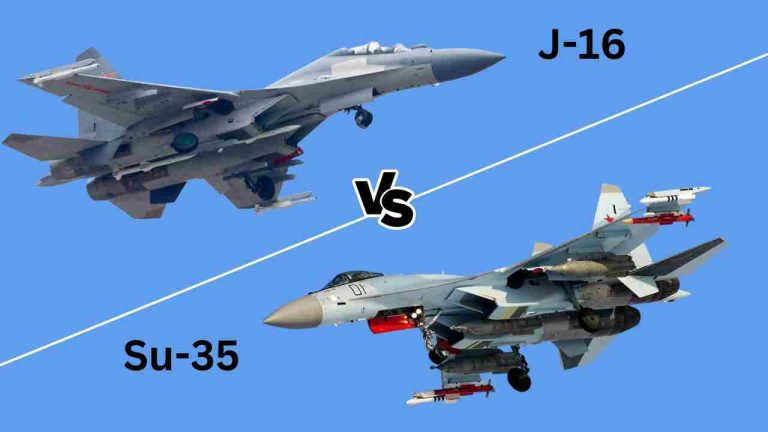J-16 vs Su-35
It’s time for an epic clash in the skies! Today, we dive into the world of fighter jets, specifically the fourth-generation powerhouses—the J-16 and the Su-35. These two magnificent birds of prey are vying for the title of the “Ultimate Flanker.” So, fasten your seatbelts and prepare for an exhilarating ride as we unravel the secrets of these formidable war machines.
The Rise of Fourth-Generation Fighters
Let’s set the stage before we embark on this thrilling aerial showdown. Over the years, first and second-generation fighters have become obsolete, with only a handful of them still in service among second and third-tier countries.
The torch has been passed to the fifth-generation fighters, but their numbers remain limited due to recent production and installation. As a result, third and fourth-generation fighters still dominate the air forces worldwide. The question arises: Which country boasts a superior third or fourth-generation aircraft that reigns supreme in overall performance and military might?
Unveiling the Gems of Fourth-Generation Fighters
We’re spoiled for choice when it comes to renowned fourth-generation fighters around the globe. The United States presents the F-15 and F-16, France showcases the Rafale fighter, and Russia unveils the Su-35. In addition to these powerhouses, China’s Shenfei Group introduces its own masterpiece—the F-16 multi-purpose heavy fighter.
Interestingly, both the J-16 and Su-35 trace their roots back to the classic Russian Su-27 fighters and belong to the esteemed “Flanker” series. These two fighters emerged as later-generation derivatives, surpassing their predecessors and cementing their position as the “Gemini” of the fourth-generation aircraft.
The Battle Begins: Avionics System
Let’s kick off our clash by examining the avionics system, the brain of these fighter jets. Here, the J-16 takes the lead with its cutting-edge technology. Thanks to the rapid development of China’s private electronics industry, the J-16 flaunts a domestically-made active phased array radar system (AESA) that leaves its competitors in the dust. Boasting a maximum detection range of 300 kilometers, this formidable radar can locate enemy fighters within close proximity and even lock onto high-value targets such as early warning and transport aircraft.

In contrast, Russia relies on the old bi-chip refraction head-up display, continuing the legacy of the Soviet era. The Chinese Air Force, however, has embraced progress, equipping not only the J-16 but also the J-10C and J-11B with advanced diffractive head-up displays.
Firepower Unleashed: J-16 in the Lead
Now, let’s turn our attention to the heart of these fighters—the firepower system. Modern fighters must be ready for combat at a moment’s notice, and their arsenal plays a pivotal role. The Su-35 boasts an impressive weapon configuration, including the R-73 short-range combat bomb, R-27 medium-range air-to-air missile, and R-77 missile.
This diverse range of missiles enables the Su-35 to excel in various combat scenarios. However, the J-16 takes the lead in terms of sheer firepower. Acting as a formidable “bomb truck,” the J-16 can carry over 10 tons of bombs, granting it unparalleled destructive power. Additionally, it can carry versatile missiles like the Pili-10, Pili-15, and Air-to-Ground-88 and even rain down devastation upon ground targets with aerial bombs and rockets. The J-16 truly embodies the spirit of “carpet bombing.”
The Engine Conundrum: J-16 Plays Catch-Up
Now, let’s soar into the skies of engine performance. Chinese fighter jets have long grappled with engine limitations, which restrict their take-off potential. While China has made significant strides in aviation engine research, it still lags behind the United States and Russia in this domain.
Equipped with a domestic “Taihang” engine, the J-16 boasts a maximum thrust of 132 kN, which can be increased to 155 kN with the latest improvements. On the other hand, the Su-35 relies on the 117S engine, delivering a maximum thrust of 142.1 kilonewtons. Russia’s latest version has seen a 16% increase in thrust—a noteworthy feat.
American and Russian Perspectives
As the heavyweight contenders in the global arena of air power, the United States and Russia have voiced their own opinions regarding Chinese and Russian aircraft. Surprisingly, they lean toward the J-16 as the superior fighter. Recently, during the “International Military Competition-2021,” the Chinese Air Force sent the J-10B and J-16 to Russia, leaving an indelible mark on the competition. The Russian military discovered that even when launching unguided rockets, the J-16 outperformed all other aircraft in the Sukhoi series, including the mighty Su-35 fighter.

According to reports from U.S. military media, the J-16 is poised to become the backbone of the People’s Liberation Army Air Force. In a head-to-head comparison with Russia’s latest “Flanker” series fighters—the Su-35 and Su-30SM—the J-16 emerges victorious in all aspects. Thus, the J-16 proudly claims the title of the most powerful fourth-generation aircraft—the “Ultimate Flanker.”
The Verdict: J-16, the Ultimate Flanker
The J-16 stands tall as the undisputed champion against the Su-35 in radar capabilities, avionics systems, and sheer firepower. Its advanced avionics system and extraordinary strike capabilities firmly establish the J-16 as the pinnacle of fourth-generation fighters. The Su-35, while a formidable adversary, falls short in these critical areas. The J-16 has earned the “Ultimate Flanker” title, a worthy testament to its exceptional performance.
So, there you have it—a thrilling glimpse into the world of fourth-generation fighter jets. The battle between the J-16 and Su-35 rages on as each fighter vies for dominance in the skies. Who will emerge victorious in the ever-evolving landscape of aerial warfare? Only time will tell. Until then, keep your eyes on the sky and marvel at the feats of these magnificent warbirds.



